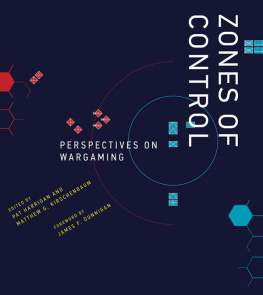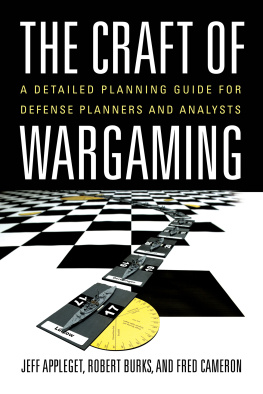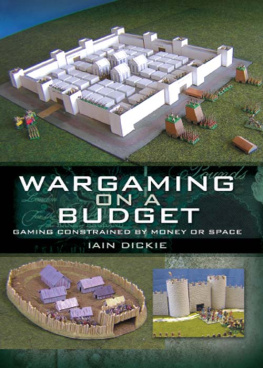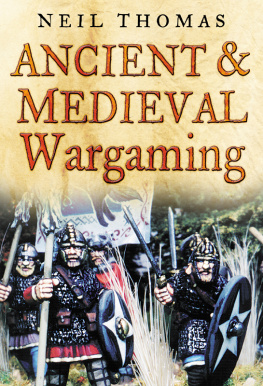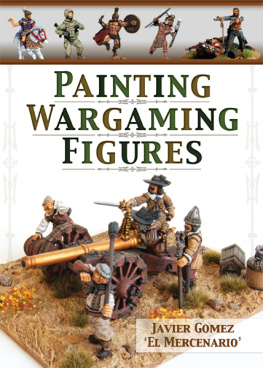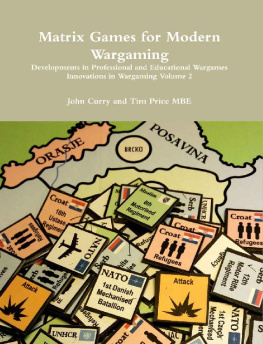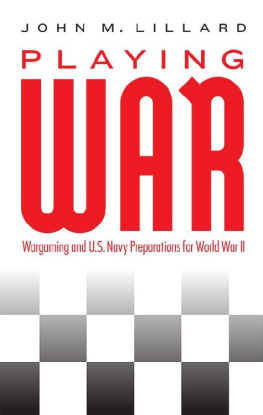Pat Harrigan - Zones of Control: Perspectives on Wargaming
Here you can read online Pat Harrigan - Zones of Control: Perspectives on Wargaming full text of the book (entire story) in english for free. Download pdf and epub, get meaning, cover and reviews about this ebook. year: 2016, publisher: MIT Press, genre: Science. Description of the work, (preface) as well as reviews are available. Best literature library LitArk.com created for fans of good reading and offers a wide selection of genres:
Romance novel
Science fiction
Adventure
Detective
Science
History
Home and family
Prose
Art
Politics
Computer
Non-fiction
Religion
Business
Children
Humor
Choose a favorite category and find really read worthwhile books. Enjoy immersion in the world of imagination, feel the emotions of the characters or learn something new for yourself, make an fascinating discovery.
- Book:Zones of Control: Perspectives on Wargaming
- Author:
- Publisher:MIT Press
- Genre:
- Year:2016
- Rating:5 / 5
- Favourites:Add to favourites
- Your mark:
- 100
- 1
- 2
- 3
- 4
- 5
Zones of Control: Perspectives on Wargaming: summary, description and annotation
We offer to read an annotation, description, summary or preface (depends on what the author of the book "Zones of Control: Perspectives on Wargaming" wrote himself). If you haven't found the necessary information about the book — write in the comments, we will try to find it.
Zones of Control: Perspectives on Wargaming — read online for free the complete book (whole text) full work
Below is the text of the book, divided by pages. System saving the place of the last page read, allows you to conveniently read the book "Zones of Control: Perspectives on Wargaming" online for free, without having to search again every time where you left off. Put a bookmark, and you can go to the page where you finished reading at any time.
Font size:
Interval:
Bookmark:
edited by Henry Lowood and Raiford Guins
Debugging Game History: A Critical Lexicon, edited by Henry Lowood and Raiford Guins, 2016
Zones of Control: Perspectives on Wargaming, edited by Pat Harrigan and Matthew Kirschenbaum, 2016
edited by Pat Harrigan and Matthew G. Kirschenbaum
The MIT Press
Cambridge, Massachusetts
London, England
2016 Massachusetts Institute of Technology
All rights reserved. No part of this book may be reproduced in any form by any electronic or mechanical means (including photocopying, recording, or information storage and retrieval) without permission in writing from the publisher.
This book was set in Gentium Book Basic and Futura by Toppan Best-set Premedia Limited. Printed and bound in the United States of America.
Library of Congress Cataloging-in-Publication Data
Names: Harrigan, Pat, editor. | Kirschenbaum, Matthew G., editor.
Title: Zones of control : perspectives on wargaming / Pat Harrigan and Matthew G. Kirschenbaum; eds. foreword by James F. Dunnigan.
Description: Cambridge, MA : The MIT Press, 2016. | Series: Game histories | Includes bibliographical references and index.
Identifiers: LCCN 2015038407 | ISBN 9780262033992 (hardcover : alk. paper)
eISBN 9780262334938
Subjects: LCSH: War gamesHistory. | War games.
Classification: LCC U310 .Z67 2016 | DDC 355.4/8dc23 LC record available at http://lccn.loc.gov/2015038407
10987654321
Pat dedicates this book to Richard Screaming Boy Smart (19702011), stalwart gaming friend, dearly missed.
Matthew dedicates this book to John Hill (19452015), designer of Squad Leader and many others.
[General William] Westmorelands strategy had always been to use the American troops as a shield behind which the GVN forces could move in to establish government security. The commanding general never quite came to terms with the fact that the war was being fought at points rather than along lines. With the support or even the neutrality of the population, the enemy forces could break up into small units and go anywhere in the countryside circumnavigating the Free World outposts. Westmoreland was trying to play chess while his enemy was playing Go.
Frances FitzGerald, Fire in the Lake
In 1961, Charles S. Roberts and Avalon Hill, the Baltimore, Maryland, company he had founded seven years earlier, published four board games with certain things in common. All four were based on historical military subjectsin fact, three out of the four concerned the American Civil War, whose centenary was that year (the other game was D-Day). All of them came with a sheet of die-cut cardboard counters, mostly a half-inch square and printed in two colors to represent the military units that fought in the particular battles and campaigns. All of them featured something called a Combat Results Table to adjudicate the outcome of individual battles within a probabilistic range based on a die roll. All four of the games also included a mapboard depicting some place in the real world, ranging in scope from the eastern half of the Continental United States to Nazi-occupied France to the ridges and roadways converging at Gettysburg, Pennsylvania, to the woods around Chancellorsville, Virginia. There is nothing about the game board in Monopoly that actually resembles the street plan of Atlantic City, but these games were differentat a glance you could see Paris relative to Calais, or where Little Round Top sat amid the fields and farms outside of a certain crossroads town. Finally, all of the maps were overlaid with the hexagonal grid that was to become wargamings most enduring visual icon. Despite the games differing topics and scope, each of them took advantage of this hex grid to implement a concept called a Zone of Control.
Mechanically, a Zone of Control (ZOC) is easy to explain: a combat units presence in any one hex is sufficient to exert some set of effects on the six hexes immediately adjacent to it. Maybe an enemy unit has to expend more movement points to enter and leave a ZOC hex (reflecting the friction of skirmishing patrols in modern warfare) or maybe the unit must immediately stop and enter into combat (reflecting what would happen when a Union and Confederate regiment found each other eyeball to eyeball across an open field). Just as important, however, a ZOC is also an artifact of the abstraction inherent in the enterprise of gaming warwars and battles, after all, are not really fought on hex grids, units dont always deploy in a consistent fashion or formation, turns are not taken sequentially by opposing battlefield commanders, and so forth. Wargames at their most fundamental, regardless of medium or motivation or scope, seek to model the brutal reality of armed conflict with a set of heuristics and formulas, conventions and physical or programmable components. As a method for representing the projection of military force in a range of scales and historical epochs, Zones of Control are thus one means toward achieving the elusive compromise between gameplay and simulation, between abstraction and realism.
For us, however, the idea of Zones of Control also suggested something more. It is a conspicuously powerful phrasing, one that we felt could be put to effective use in editing a book about wargames in multiple media, formats, and player communities. Why edit such a book at all? Most all of our readers will already know that games with military themes date back to antiquity, as Jon Peterson reminds us in his opening chapter. For all of their historical variety however, wargames remain underserved by the established academic and trade literature on games and game history. Many popular writers seem content to move from a token acknowledgment of chess or Go or Chaturanga to the first-person shooter. At other times wargames are treated in a cursory manner, obligatory to mention but best not lingered over on the way to more tempting (and less bellicose) fare involving magic or meeples. Sometimes there is a slightly more nuanced genealogy invoking the Prussian Kriegsspiel or H. G. Wellss Little Wars (1913), and perhaps a mention of Avalon Hill or Simulations Publications, Incorporated (SPI), before arriving at the presumptive finality of the digital present. By contrast, Zones of Control seeks to offer a richer and more granular set of perspectives on wargamings past, present, and future, particularly in its Western contexts.
The kind of wargames we have in mind are generally those games that cover specific historical conflictswars, battles, and campaignsas well as games grounded in recognizable real-world geopolitics. (Wargames set in fantastical or science-fictional contexts are largely, though not entirely, absent from this book.) We mean both recreational or commercial games as well as those employed by professional militaries and policymakers. We mean games that attempt to interpret and understand past conflicts, and those that seek to model and forecast potential future ones. And we mean games played on both tabletops and on screens, which is to say games in both analog and digital media. The taxonomies and genealogies here are complex, and cannot be disambiguated simply by recourse to medium and method or even the play of a particular game system. Gaming at the Naval War College at Newport, Rhode Island for example, has historically involved computer simulations, role-playing and discussion, and officers moving miniature ships around on the floor with rulers and protractors. Recreational or hobby games about naval warfare have also been published in most of these formats, indeed sometimes utilizing the same rule sets or game engines (such was the case with both Fred Janes miniatures rules in the early twentieth century and the
Font size:
Interval:
Bookmark:
Similar books «Zones of Control: Perspectives on Wargaming»
Look at similar books to Zones of Control: Perspectives on Wargaming. We have selected literature similar in name and meaning in the hope of providing readers with more options to find new, interesting, not yet read works.
Discussion, reviews of the book Zones of Control: Perspectives on Wargaming and just readers' own opinions. Leave your comments, write what you think about the work, its meaning or the main characters. Specify what exactly you liked and what you didn't like, and why you think so.

